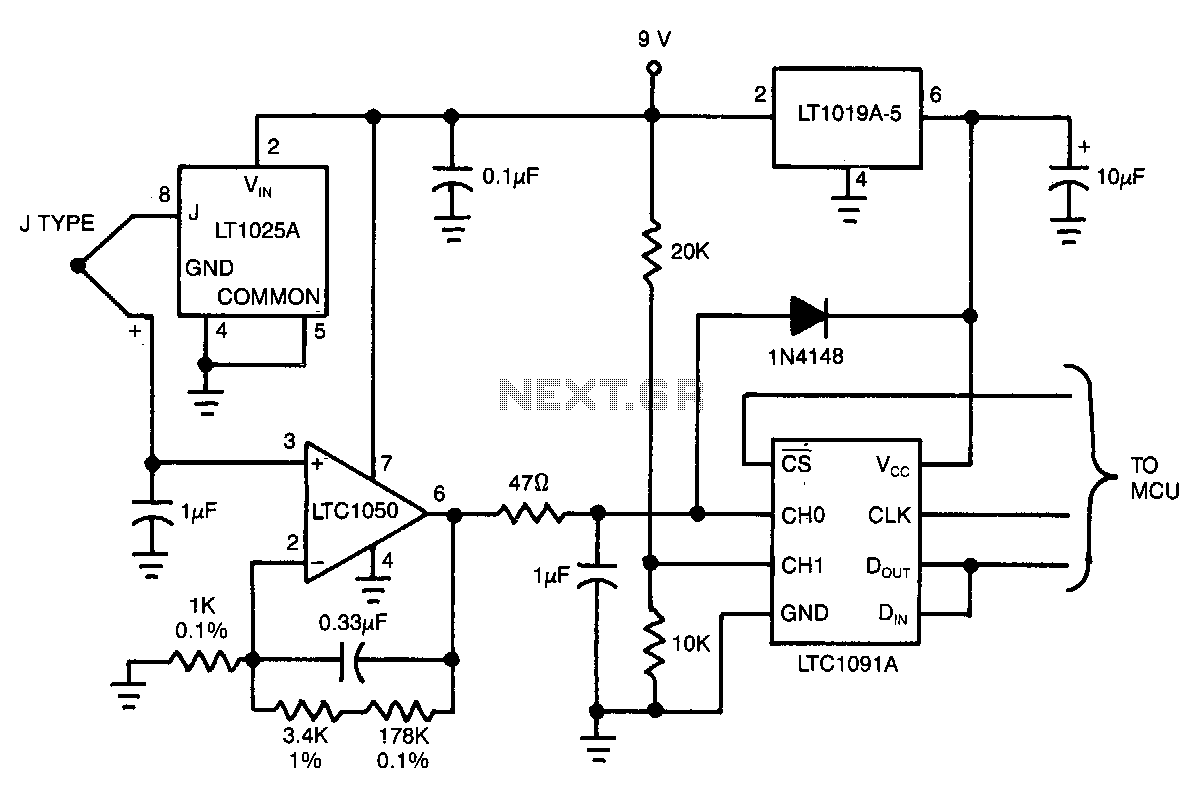
Gas-temperature-monitor-detection

This circuit is designed to measure the exhaust gas temperature in a furnace. The 10-bit LTC1091A provides a resolution of 0.5°C over a temperature range of 0°C to 500°C. The LTC1050 amplifies and filters the thermocouple signal, while the LT1025A offers cold junction compensation, and the LT1019A supplies an accurate reference voltage. The characteristics of the J-type thermocouple are digitally linearized within the microcontroller unit (MCU). Linear interpolation between known temperature points, spaced 30°C apart, results in an error of less than 0.1°C. A 20 kΩ/10 kΩ voltage divider connected to channel 1 (CH1) of the LTC1091 enables low supply voltage detection. The circuit allows for remote location, with data transmitted from the MCU to the LTC1091 using a three-wire serial interface.
The exhaust gas temperature measurement circuit operates effectively within its specified parameters, leveraging the precision of the LTC1091A analog-to-digital converter (ADC) to convert the thermocouple voltage into a digital signal. The ADC's 10-bit resolution ensures that temperature readings are accurate and reliable, making it suitable for monitoring critical processes in furnace applications.
The LTC1050 operational amplifier plays a crucial role in conditioning the thermocouple signal, amplifying the small voltage produced by the thermocouple and filtering out noise that may interfere with accurate readings. This amplification is essential, as thermocouples typically generate low-level signals that require enhancement for effective processing.
Cold junction compensation is vital in thermocouple applications, and the LT1025A component achieves this by compensating for the temperature at the connection point of the thermocouple. This compensation is necessary to ensure that the temperature readings are accurate, as thermocouple outputs are dependent on the temperature difference between the measurement junction and the reference junction.
The LT1019A is utilized as a precision voltage reference, providing a stable reference voltage that enhances the accuracy of the ADC readings. This reference ensures that fluctuations in the power supply do not affect the measurement accuracy.
Digital linearization of the J-type thermocouple characteristics within the MCU allows for precise temperature calculations. By employing linear interpolation between known temperature points, the system minimizes measurement errors, enhancing the overall reliability of the temperature data.
The inclusion of a 20 kΩ/10 kΩ voltage divider on channel 1 of the LTC1091 enables the detection of low supply voltages, ensuring that the circuit can operate within safe limits and preventing erroneous readings due to inadequate power supply.
For remote applications, the circuit is designed for efficient data transmission from the MCU to the LTC1091 via a three-wire serial interface. This feature simplifies the integration of the temperature measurement system into larger control systems, allowing for flexible placement of the temperature sensing components without compromising data integrity.
Overall, this circuit design is well-suited for applications requiring accurate and reliable exhaust gas temperature measurements in industrial furnace environments.This circuit can be used to measure exhaust gas temperature in a furnace. The 10-bit LTC1091A gives 0.5°C resolution over a ooc to 500°C range. The LTC1050 amplifies and filters the thermocouple signal, the LT1025A provides cold junction compensation and the LT1019A provides an accurate reference. The ]-type thermocouple characteristic is linearized digitally inside the MCU. Linear interpolation between known temperature points spaced 30°C apart introduces less than 0.1 oc error. The 20-K/10 KO divider on CHI of the LTC1091 provides low supply voltage detection. Remote location is easy, with data transferred from the MCU to the LTC1091 via the three-wire serial part.
The exhaust gas temperature measurement circuit operates effectively within its specified parameters, leveraging the precision of the LTC1091A analog-to-digital converter (ADC) to convert the thermocouple voltage into a digital signal. The ADC's 10-bit resolution ensures that temperature readings are accurate and reliable, making it suitable for monitoring critical processes in furnace applications.
The LTC1050 operational amplifier plays a crucial role in conditioning the thermocouple signal, amplifying the small voltage produced by the thermocouple and filtering out noise that may interfere with accurate readings. This amplification is essential, as thermocouples typically generate low-level signals that require enhancement for effective processing.
Cold junction compensation is vital in thermocouple applications, and the LT1025A component achieves this by compensating for the temperature at the connection point of the thermocouple. This compensation is necessary to ensure that the temperature readings are accurate, as thermocouple outputs are dependent on the temperature difference between the measurement junction and the reference junction.
The LT1019A is utilized as a precision voltage reference, providing a stable reference voltage that enhances the accuracy of the ADC readings. This reference ensures that fluctuations in the power supply do not affect the measurement accuracy.
Digital linearization of the J-type thermocouple characteristics within the MCU allows for precise temperature calculations. By employing linear interpolation between known temperature points, the system minimizes measurement errors, enhancing the overall reliability of the temperature data.
The inclusion of a 20 kΩ/10 kΩ voltage divider on channel 1 of the LTC1091 enables the detection of low supply voltages, ensuring that the circuit can operate within safe limits and preventing erroneous readings due to inadequate power supply.
For remote applications, the circuit is designed for efficient data transmission from the MCU to the LTC1091 via a three-wire serial interface. This feature simplifies the integration of the temperature measurement system into larger control systems, allowing for flexible placement of the temperature sensing components without compromising data integrity.
Overall, this circuit design is well-suited for applications requiring accurate and reliable exhaust gas temperature measurements in industrial furnace environments.This circuit can be used to measure exhaust gas temperature in a furnace. The 10-bit LTC1091A gives 0.5°C resolution over a ooc to 500°C range. The LTC1050 amplifies and filters the thermocouple signal, the LT1025A provides cold junction compensation and the LT1019A provides an accurate reference. The ]-type thermocouple characteristic is linearized digitally inside the MCU. Linear interpolation between known temperature points spaced 30°C apart introduces less than 0.1 oc error. The 20-K/10 KO divider on CHI of the LTC1091 provides low supply voltage detection. Remote location is easy, with data transferred from the MCU to the LTC1091 via the three-wire serial part.